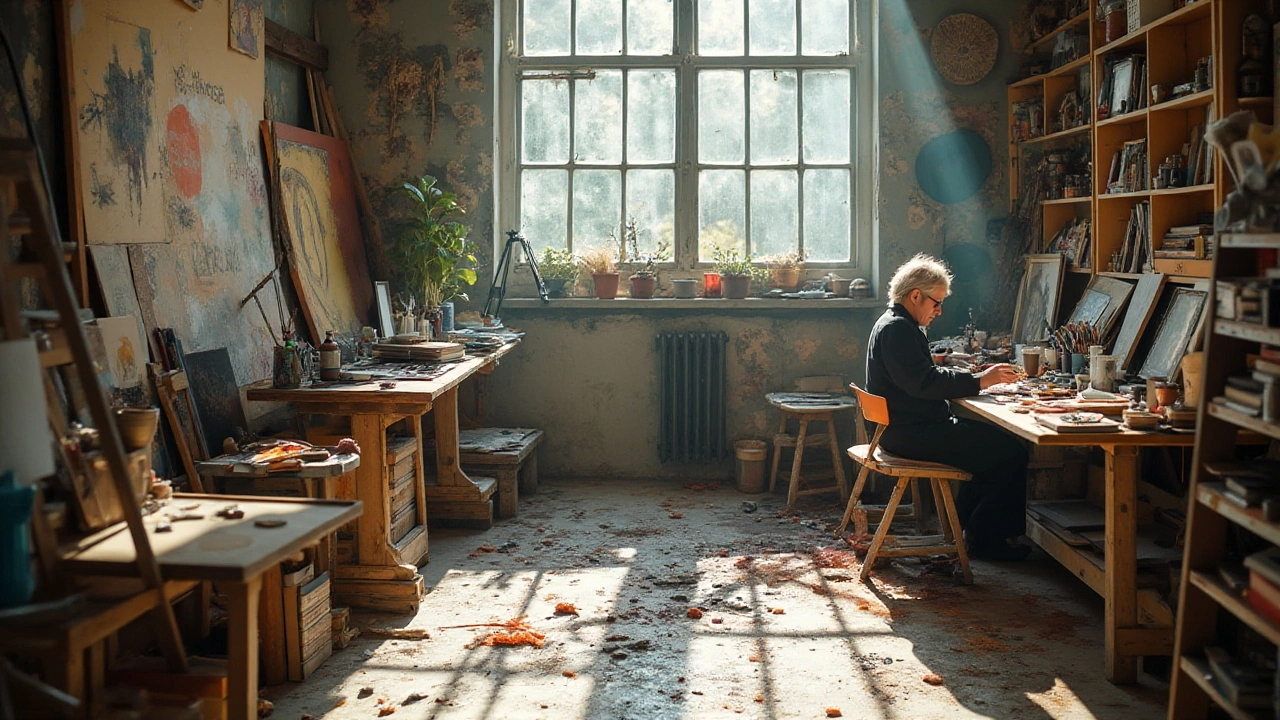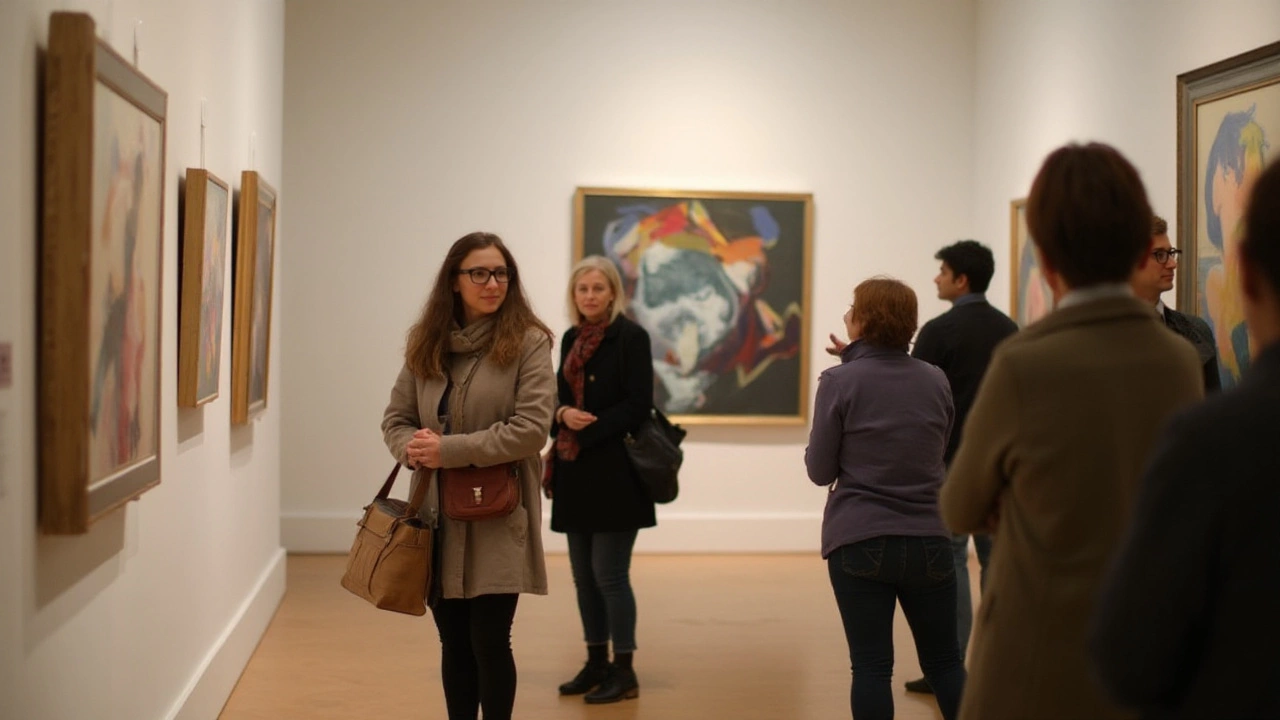Abstract art often leaves us searching for words to adequately express its rich and layered meanings. When an artwork veers away from literal depiction, we delve into a world where shapes, colors, and forms dance without direct correlation to everyday reality. This is where synonyms become crucial, each lending a unique perspective to our understanding of abstraction. By exploring five terms synonymous with 'abstract,' we can uncover deeper insights into the art form, helping both creators and observers articulate this enigmatic style.
The journey through abstract art is as much about personal interpretation as it is about the artist's intent. It's a dance between what's seen and what is felt, where viewers are invited to embark on a journey of imagination and emotion. As we dissect these synonyms, we will reveal the nuances that each term brings to the abstract landscape, enriching our dialogue and comprehension of this visual language.
- Defining Modern Art Abstraction
- Nonfigurative: Beyond the Physical
- Conceptual: Ideas as Imagery
- Intangible: Art with Invisible Threads
- Nonrepresentational: Embracing The Abstract
Defining Modern Art Abstraction
In the realm of abstract art, modern abstraction has emerged as a captivating frontier, inviting both creators and observers to experience a world unfettered by literal representation. The roots of this artistic movement can be traced back to the late 19th and early 20th centuries, when artists began to challenge the traditional emphasis on mimetic representation that had dominated Western art. Abstraction heralded a departure, urging a shift toward exploring form, color, and line beyond their utilitarian roles as mere components of reality.
The evolution of abstraction during this epoch was marked by significant avant-garde movements such as Cubism, pioneered by artists like Pablo Picasso and Georges Braque, and Expressionism, with figures like Wassily Kandinsky and Franz Marc at the forefront. Their work signified more than mere aesthetic experimentation; it was a daring philosophical quest to capture the essence of the world beyond the visible. Kandinsky, in particular, often opined that art should reflect spiritual experiences, famously asserting, "Color is a power which directly influences the soul."
"Art should not be painted just by the hand, it must be impregnated with the soul of the artist," wrote Kandinsky in his seminal text, Concerning the Spiritual in Art.
Early Pioneers and Their Inspirations
While early abstract art was often rooted in philosophical and spiritual ideals, it also drew inspiration from the rapidly changing world. The industrial revolution had reshaped urban landscapes and human experiences, offering a rich tapestry of stimuli that artists sought to encapsulate. This period was characterized by rapid technological advances and the burgeoning complexity of life, which fueled an artistic desire to express the intangible aspects of these changes. Consequently, the nature of modern abstraction became entwined with a quest for new techniques and forms of expression that could articulate these unseen dynamics.
Artists such as Kazimir Malevich and Piet Mondrian further pioneered the abstraction movement, striving for simplicity and purity of form. Malevich's 'Black Square,' often considered a quintessential work of abstract art, rejected objectivity entirely, offering instead a raw, emotional engagement with the canvas. Mondrian's pursuit of 'pure abstraction' through his work in the De Stijl movement emphasized harmony and balance using straight lines and primary colors, reflecting a meditative, spiritual order amid the chaos of modern life. A worldview captured in their work echoes the interconnectivity between the objective and subjective worlds, bridging experiences through nonfigurative means.
The Humanist and Emotional Dimensions
A defining feature of modern abstract art is its ability to evoke profound emotional responses, allowing viewers to engage with art on a more personal, introspective level. This interaction reflects abstraction's capacity to transcend cultural and linguistic barriers, speaking the universal language of human emotion. Abstract art serves as a mirror, reflecting the creator’s intellect and emotion while drawing viewers into a dialogue about their own interpretations and responses. It is through this synergy that abstract art continues to resonate, providing a timeless reflection of the ever-evolving human condition.
Statistics from art surveys indicate that over 75% of art enthusiasts perceive abstract art as emotionally provoking, often interpreting it in diverse ways based on personal contexts. Such engagement is testament to the genre’s enduring appeal and relevance. Hence, defining modern art abstraction is not just about understanding historical movements or artistic techniques; it is about embracing an ongoing conversation that challenges, invites curiosity, and encourages a deeper understanding of oneself and the intricate world we inhabit.
Nonfigurative: Beyond the Physical
Nonfigurative art, also known as nonrepresentational art, pushes the boundaries of what many consider traditional art forms. It escapes the confines of physical reality and delves into a realm where the subject is not derived from recognizable objects. Instead, this art form encapsulates emotions, thoughts, and conceptual ideas, often leaving it to the viewer's imagination to decipher its essence. Abstract art, in this context, gains a new dimension—one that is refreshingly free and unconventionally challenging. This form of art reflects a movement away from straightforward depiction, making room for a more intuitive and experimental approach.
Historical movements such as Cubism and Abstract Expressionism have contributed significantly to the development of nonfigurative art. These movements questioned the necessity of representing reality as it is perceived by the senses, opening new pathways for artists to explore unseen realms. It’s an intriguing departure from tradition, where color, line, and form became subjects in their own right, no longer confined to imitate reality. Nonfigurative art affords the artist the liberty to use intuition to compose artworks that are deeply personal and resonate on a sub-conscious level.
The artistic pioneers who spearheaded this change include well-known figures like Wassily Kandinsky, who believed in the spiritual power of art. “The artist must train not only his eye but also his soul,” he once said, highlighting the deep, often metaphysical connection between the creator and the canvas. Kandinsky saw music as a key influence, attempting to translate auditory experiences into visual forms, which illustrates the essence of nonfigurative art—capturing the invisible and presenting it tangibly. This form of art challenges observers to disengage from preconceived notions and explore the invisible dimensions of human emotion and thought.
The dialogue around nonfigurative art continues to evolve, inviting both artists and audiences into conversations about the nature of reality and perception. It encourages questions without easy answers, nudging us towards intellectual and emotional exploration. In today’s world, the definition and reception of nonfigurative art are continually expanding, mirroring the eclectic and often fragmented experiences of modern life. This makes it an intriguing field of study for anyone interested in the intersections of perception, interpretation, and artistic expression.
While traditional art often strives for a depiction of reality, nonfigurative art invites an inward journey, where the ultimate destination is not a defined picture but a resonance of inner experience. Through colors, shapes, and unpredictable patterns, this art form reaches beyond physical boundaries, connecting deeply with the psyche. For those seeking to delve into the exciting world of nonrepresentational art, the journey is enriched by an understanding of these undercurrents, making every piece not just an artwork, but an adventure of perception. Discovering nonfigurative art is akin to traveling uncharted territories of creativity, where the map is not written, and each step uncovers a new perspective on what art can actually be.
The exploration of abstract art in its nonfigurative aspect provides a vast playground for the imagination. As it prompts conversations about art’s true purpose and the role it plays in human experience, it holds a mirror to society’s changing landscapes and the evolving human condition. In engaging with nonfigurative art, we practice seeing beyond the immediate, inviting a deeper engagement with the unfamiliar and the unknown.

Conceptual: Ideas as Imagery
At the heart of conceptual art lies the transformation of ideas into visual language. This artistic approach dares to transcend the boundaries of traditional aesthetics, pushing beyond the mere beauty of form to prioritize the essence of meaning itself. As concepts come to life, they invite viewers to engage deeply with the underlying messages and reflections that these pieces aim to convey. Conceptual art challenges the viewer to not just see, but to think and feel, making the experience both an intellectual and emotional exploration. This facet of artistic endeavor reaches into the core of human perception, demanding active participation from its audience.
Throughout history, artists have leveraged conceptual methodologies to comment on social, political, and cultural paradigms. An excellent instance is the work of Sol LeWitt, a pioneer known for his assertion that "the idea becomes a machine that makes the art."
LeWitt famously declared, "Ideas alone can be works of art; they are in a chain of development that may eventually find some form."His works often began as simple, yet profound proposals, leaving the execution to be interpreted by others. This process highlights the power of ideas and how they play as pivotal roles as the visual component itself.
For those delving into abstract art, particularly the conceptual realm, understanding the artist’s intention can significantly enrich the experience. Consider the thought-provoking installations of artist Yoko Ono, whose pieces like the "Cut Piece" from 1964 invited the audience to participate, provoking contemplation on themes of vulnerability and trust. Conceptual art, in its abstract essence, often eschews conventional techniques, pushing boundaries to explore the fluidity of interpretation. This freedom can stimulate discussions on the nature of art and the potency of creativity as a tool for insight and change.
Engaging with conceptual art requires an open mind and a willingness to delve into the abstract narratives presented. Unlike more traditional forms that rely on structured beauty, conceptual artworks transform emotions like curiosity, doubt, and inspiration into nonfigurative visuals that provoke rather than pacify. By cultivating an appreciation for these artistic expressions, one can gain a deeper understanding not only of the artwork's surface but, more importantly, its profound and potentially transformative undertones.
It is not uncommon for conceptual artists to employ socio-political themes or explore personal introspection. Their works challenge our perceptions and encourage personal reflection, often bridging the gap between the tangible and intangible. This dynamic makes conceptual art a powerful medium within the larger sphere of abstract art, offering endless possibilities for interpretation and engagement. As such, individuals exploring these artworks must do so with a sense of curiosity and open-mindedness, ready to uncover the nuanced stories waiting within each piece.
Intangible: Art with Invisible Threads
When we delve into the world of abstract art, the term intangible often surfaces, especially when describing works that evoke emotion but evade description. This quality refers to the ethereal essence of art, the unseen threads that weave together to form a tapestry of feelings and ideas impervious to physical grasp but profoundly impactful. Intangible components in abstract art challenge our perception. They invite us to explore not what we see, but what we sense, ushering us into a realm where imagination meets interpretation. Imagine a painting with swirls of colors that don't resolve into any familiar form; the intrigue lies not in what it represents, but in how it resonates.
Such art transcends what is visible. It becomes a dialogue between the artist and the observer, a conversation spoken in the silent language of shapes and hues, with each viewer hearing a different story. This unique interaction is powered by the intangibility of the art. Unlike traditional art that may dictate a particular narrative or emotion, intangible art provides a space for personal reflection. It’s like a musical composition that allows listeners to take from it what resonates personally. As Wassily Kandinsky, a pioneer in abstraction, once mentioned,
“The more frightened I am of something, the more I know I have to face it. And then the question is, how do I try to face it?”This reflects the courage required to both create and engage with intangible art, asking us to embrace ambiguity and introspection.
In this context, abstract art achieves what words often cannot. It reaches the depths of human emotions, igniting something primal and deeply personal. Viewers are often moved to inquire about the meanings behind such works or what inspired the artist. Yet, many abstract artists aim to evoke an emotional response rather than convey a message, thus leaving their work delightfully open-ended. This openness is at the very heart of intangibility—a boundless creative field for both artist and viewer, a meeting of minds free from restraint. Through this exchange, art becomes not just a medium of beauty, but a conduit for connection, transcending time and space to reach us in ways literal depiction cannot.
Understanding the therapeutic aspect of abstract art is another facet of its intangibility. Many have noted how engaging with such art can soothe the mind, acting as a balm for the soul. The abstract form offers solace by allowing viewers to lose themselves in its depths, momentarily escaping reality. Interestingly, research demonstrates how abstract art can promote a state of mindfulness, leading to reduced stress and heightened creativity. For those who seek deeper meaning or a different perspective, abstract art can provide a unique avenue of expression and contemplation, striking chords that could otherwise remain dormant in more tangible art forms.

Nonrepresentational: Embracing The Abstract
In the ever-evolving world of abstract art, the term 'nonrepresentational' serves as a cornerstone of understanding. Unlike traditional art forms that depict explicit images from reality, nonrepresentational art abandons these visual constraints to explore conceptual realms. This art style refrains from offering depictions of distinct entities, such as a tree or a person, favoring the expression of intangible ideas through shapes, colors, and movements. At the heart of nonrepresentational art lies the artist's freedom to convey emotion and thought without being tethered to direct symbolism.
This genre invites viewers to embark on an interpretive journey, drawing connections between the artwork and their personal experiences. Each brushstroke, hue, or texture crafted by the artist serves as a universal language, inviting diverse interpretations based on an individual's unique perspective. This approach to art was notably advanced during the early-to-mid 20th century, with renowned artists like Wassily Kandinsky championing the move away from the representational confines. Kandinsky believed that colors and forms could stand alone to provoke an aesthetic experience, devoid of narrative restrictions, claiming that the true purpose of art was to reach into the soul of the observer.
"Every artist dips his brush in his own soul, and paints his own nature into his pictures." - Henry Ward BeecherHis sentiment echoes today's understanding of nonrepresentational art as an expression of the artist's inner existence. The significance of art without recognizable forms lies in its power to stir emotions and inspire thoughts out of the ordinary, thereby nudging individuals to ponder deeper philosophical questions about art and existence. Such a practice not only enriches the viewer's artistic experience but also demands a participatory role, encouraging contemplation and dialogue about the nature and purpose of nonrepresentational artworks.
An intriguing aspect of nonrepresentational art is its reliance on the principles of design and balance. Unlike representational art, where the subject matter often dictates composition, here the balance of elements creates harmony. Artists must skillfully wield aspects like symmetry, color contrast, and spatial relationships to compose their pieces compellingly. This is not only a creative challenge but also a testament to the artist's technical prowess. Evidence and scholarship on the effectiveness of design elements can sometimes be observed in academic studies, showcasing their power in engaging the audience's senses on more than one level.
For someone new to this art form, an excellent approach is to view it with an open mind, letting the emotions guide your interpretation rather than trying to decipher a concrete meaning. Make sure you don't rush; abstract art, particularly nonrepresentational, is best understood when given time and reflection. When engaging with such pieces, questioning what feelings are evoked is more beneficial than trying to ascertain what it 'means.' Such open-eyed curiosity leads to a richer appreciation and understanding of the art, enticing seekers into a more profound dialogue with what they see.

